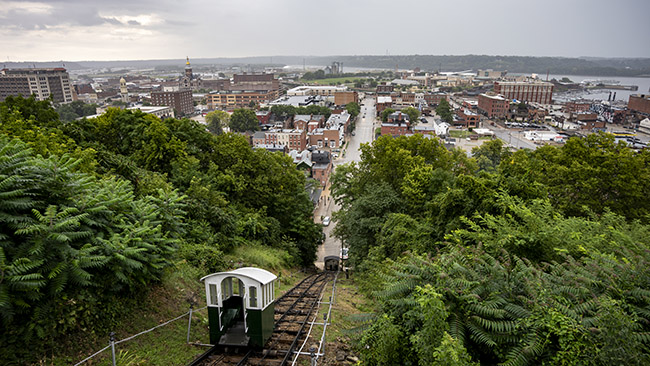Time once again to share some auxiliary images I took while harvesting the town signs of Dubuque County. Last time we left off I was sharing pictures from the Fenelon Place Elevator. Here is some more information on the “world’s shortest and steepest railway” (https://www.fenelonplaceelevator.com/):
Fenelon Place Elevator Company
512 Fenelon Place
Dubuque, Iowa 52001Historic cable car. Also known as the Fourth Street Elevator, this funicular railway has been called “the world’s steepest, shortest scenic railway.” 296 feet in length, elevating passengers 189 feed from Fourth Street up to Fenelon Place. Magnificent view of downtown Dubuque business district, the Mississippi River and three states. Buses should go to the bottom of the bluff. Please use 4th and Bluff Streets for GPS. Narrow streets with parking on both sides at the top of the bluff. Open 8 AM to 10 PM daily April 1 though November 30. Closed Thanksgiving. We do not accept debit or credit cards.
And from the history section of their website:
In 1882, Dubuque was an hour and a half town – at noon everything shut down for an hour and a half when everyone went home to dinner.
Mr. J. K. Graves, a former mayor, former State Senator, also promoter of mines and a banker lived on top of the bluffs and worked at the bottom. Unfortunately, he had to spend half an hour driving his horse and buggy round the bluff to get to the top and another half an hour to return downtown, even though his bank was only two and a half blocks away.
Mr. Graves liked to take half an hour for his dinner, then a half an hour nap, but this was im-possible because of the long buggy ride.
As a traveler he had seen incline railways in Europe and decided that a cable car would solve his problem. He petitioned the city for the right to build. The franchise was granted on June 5, 1882.
John Bell, a local engineer, was hired to design and to build a one-car cable modeled after those in the Alps.
The original cable car, which was built for Mr. Graves’ private use, had a plain wood building, that housed a coal-fired steam engine boiler and winch. A wooden Swiss-style car was hauled up and down on two rails by a hemp rope.
Mr. Graves’ cable car operated for the first time on July 25, 1882. After that, he had his gardener let him down in the morning, bring him up at noon, down after dinner and nap, and up again at the end of the work day. Before long, the neighbors began meeting him at the elevator asking for rides.
On July 19, 1884, the elevator burned when the fire that was banked in the stove for the night was blown alive. After Mr. Graves rebuilt the elevator, he remembered how his neighbors showed up when he used the cable car and he decided to open it to the public. He charged five cents a ride.
The elevator burned again in 1893. Because there was a recession Mr. Graves could not afford to rebuild the cable car. The neighbors had come to depend on the elevator to get them to work, to church, to school, and to the market.
Ten neighbors banded together and formed the Fenelon Place Elevator co. Mr. Graves gave them the franchise for the right of way for the track. This group traveled to the 1893 Colombian Exposition in Chicago, Illinois, to look for new ideas. They brought back a streetcar motor to run the elevator, the turnstile, and steel cable for the cars. They had remembered that each time the elevator house burned, the fire also burned through the hemp rope that held the car and sent it crashing down the hill destroying it and the little house at the bottom. Then they in-stalled three rails with a fourth bypass in the middle to allow for the operation of two (funicular) counterbalanced cars.
By 1912, C. B. Trewin, who had built a house next door in 1897, became the sole stockholder. It was natural for him to buy up the stock from the original ten stockholders as they either passed away or moved away.
Mr. Trewin added garages to the north and south sides of the operator’s house in 1916. He also added a second floor apartment which the neighborhood men used for a meeting room where they could smoke and play cards without the wives interfering.
The auxiliary images:

Fenelon Place Elevator
There is only one collection in this post of the many amazing murals in Dubuque. I actually did a little more research into the murals of Dubuque and they are a lot more extensive than I thought. I will definitely be going back to Dubuque at some point to photograph as many of them as possible!
There is still one more collection of images from Dubuque County left to share!






























